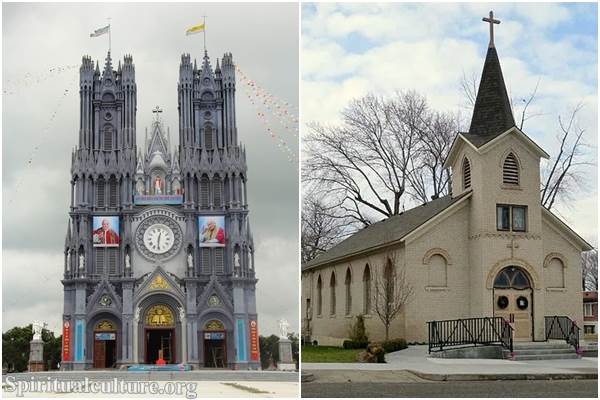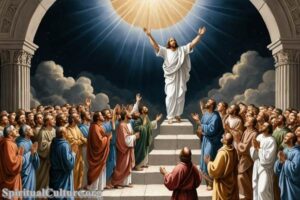Catholicism and Protestantism
Catholicism is the oldest and largest Christian denomination, tracing its roots back to the early Christian Church founded by Jesus Christ. The Catholic Church teaches that it is the one true Church founded by Christ and is led by the Pope, who serves as the successor to Saint Peter, the first Bishop of Rome. Catholics believe in the doctrine of the Holy Trinity, the divinity of Jesus Christ, and the importance of the sacraments, including the Eucharist, Baptism, and Confession.
Protestantism, on the other hand, emerged in the 16th century as a movement to reform the Catholic Church, led by figures such as Martin Luther and John Calvin. Protestantism emphasizes the authority of the Bible and rejects some Catholic practices and doctrines, such as the authority of the Pope and the belief in purgatory. Protestants believe in justification by faith alone, rather than through good works or sacraments.

While there are many differences between Catholicism and Protestantism, both share a belief in the centrality of Jesus Christ and the importance of living a life of faith and love. In recent years, there has been increasing dialogue and cooperation between Catholics and Protestants, although some differences remain contentious.
Summarize some of the Catholic and Protestant differences
Here is a table outlining some of the key differences between Catholicism and Protestantism:
| Topic | Catholicism | Protestantism |
|---|---|---|
| Authority | The Pope and Magisterium (teaching authority of the Church) | The Bible as the ultimate authority |
| Salvation | Achieved through faith and good works | Achieved through faith alone |
| Sacraments | Seven sacraments, including baptism, confirmation, Eucharist, reconciliation, anointing of the sick, holy orders, and marriage | Two sacraments, baptism and Eucharist (some denominations may also recognize other sacraments) |
| Worship | Emphasis on liturgical worship and the sacraments | Emphasis on individual worship and preaching |
| Mary and the Saints | Reverence for Mary and the saints, who can intercede for believers | No intercession of saints; emphasis on direct relationship with God |
| Clergy | Celibate priesthood and male-only ordination | Emphasis on the priesthood of all believers; some denominations allow female and/or married clergy |
| Religious Orders | Monastic and religious orders | No monastic or religious orders in most Protestant denominations |
| Communion | Transubstantiation (belief that the bread and wine become the actual body and blood of Christ) | Consubstantiation (belief that Christ is present in the bread and wine, but they remain bread and wine) or symbolic representation |
It’s worth noting that there is a great deal of diversity within both Catholicism and Protestantism, and these differences may not apply to every individual or denomination within each tradition.
The differences between Catholicism and Protestantism
Here is a more detailed explanation of the differences between Catholicism and Protestantism on the topics outlined in the table:
Authority
Catholicism recognizes the Pope, who is seen as the successor of St. Peter, as the head of the Church and the ultimate authority in matters of faith and morals. The Magisterium, which includes the Pope and bishops, has the teaching authority of the Church and is responsible for interpreting Scripture and tradition.
Protestantism, on the other hand, emphasizes the Bible as the ultimate authority in matters of faith and practice. The doctrine of sola scriptura, or “Scripture alone,” holds that the Bible is the only infallible source of Christian teaching and that it can be understood by the individual believer through the guidance of the Holy Spirit.
Salvation
Catholicism teaches that salvation is achieved through faith and good works. While faith is necessary for salvation, good works are also necessary to demonstrate that one has truly accepted the gift of salvation and to grow in holiness.
Protestantism, on the other hand, emphasizes that salvation is achieved through faith alone. This doctrine, known as sola fide, holds that salvation is a free gift of God that cannot be earned or deserved, and that it is received through faith in Jesus Christ.
Sacraments
Catholicism recognizes seven sacraments: baptism, confirmation, Eucharist, reconciliation, anointing of the sick, holy orders, and marriage. These sacraments are considered to be signs of God’s grace, and they are believed to confer spiritual benefits on those who receive them.
Protestantism generally recognizes two sacraments: baptism and the Eucharist (also known as Communion or the Lord’s Supper). Some Protestant denominations may also recognize other sacraments, such as confirmation or marriage, but they generally do not hold that these sacraments are necessary for salvation.
Worship
Catholicism emphasizes liturgical worship, which includes the celebration of the sacraments and the use of formal prayers and rituals. The Mass, which is the central act of Catholic worship, is celebrated according to a set liturgy that is largely the same around the world.
Protestantism, on the other hand, places more emphasis on individual worship and preaching. Worship services are often less formal and may include contemporary music, personal testimony, and other elements designed to engage the congregation.
Mary and the Saints
Catholicism places a great deal of emphasis on the Virgin Mary and the saints, who are seen as special intercessors with God. Catholics may pray to Mary and the saints to ask for their intercession, and they may also venerate relics and icons associated with these holy figures.
Protestantism generally does not recognize the intercession of saints, and places more emphasis on the direct relationship between the individual believer and God. While Protestants may acknowledge the important role that Mary and the saints played in Church history, they do not generally venerate them or seek their intercession.
Clergy
Catholicism has a hierarchical structure, with the Pope at the top, followed by bishops, priests, and deacons. The Catholic priesthood is celibate, and only men can be ordained as priests or bishops.
Protestantism, on the other hand, places more emphasis on the “priesthood of all believers,” which holds that all Christians have direct access to God and do not need an intermediary to approach him. While some Protestant denominations do have ordained clergy, they may allow women and/or married individuals to be ordained.
Religious Orders
Catholicism has a long tradition of monastic and religious orders, which are groups of men or women who live in community and dedicate themselves to a life of prayer, service, and contemplation. These orders often have a particular focus, such as teaching, nursing, or missionary work, and they may take vows of poverty, chastity, and obedience. Members of religious orders may live in convents or monasteries and may wear distinctive clothing or habits.
Protestantism generally does not have monastic or religious orders in the same way that Catholicism does. While there are some Protestant communities, such as the Amish or the Mennonites, that live in intentional communities and have a particular way of life, these are not typically considered religious orders.
Communion
Catholicism teaches that the bread and wine used in the Eucharist become the actual body and blood of Christ through a process known as transubstantiation. This means that the bread and wine are no longer bread and wine, but rather the actual physical presence of Christ.
Protestantism generally does not hold to the doctrine of transubstantiation, and instead holds to the doctrine of consubstantiation or symbolic representation. In consubstantiation, it is believed that Christ is present in the bread and wine, but they remain bread and wine. In symbolic representation, the bread and wine are seen as symbols of the body and blood of Christ, rather than as the actual physical presence of Christ.
It’s important to note that these are broad generalizations, and that there is a great deal of diversity within both Catholicism and Protestantism. Different denominations within each tradition may have different beliefs and practices, and individual believers may interpret and practice their faith in different ways.


